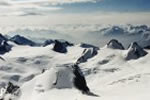


 |
 |
 |

Everybody needs fresh water. Without water people, animals and plants cannot live. Although a few plants and animals can make do with saltwater, all humans need a constant supply of fresh water if they are to stay fit and healthy. Of the total supply of water on the Earth, only about 3 percent of it is fresh, and most of that is stored as ice and snow at the poles, or is so deep under the surface of the Earth that we cannot get to it. Despite so much of the water being out of reach, we still have a million cubic miles of it that we can use. That's about 4,300,000 cubic kilometers of fresh water to share out between most of the plants, animals and people on the planet.
Whether water is clean enough to use, or too polluted depends on many things such as where it is, whether there is enough for everyone to use, what we do with it, and how we deal with the water we have used before we let it run back to join the rivers and lakes.
The Developing World
In the developing world the biggest problem is the shortage of water and the lack of clean supplies. When water is very scarce people have to make good use of it. That might mean using the same source of water for drinking and cooking, a place to wash, a place to clean clothing, pots and pans and a place to let the farm animals drink as well. The same water is used by many people for many different purposes, and each time the water becomes a little more polluted.
Imagine a river that is the only source of water for
a series of farming villages along its banks.
The people in the first village might be very careful and always get
their drinking water from above the village, do all their washing a little
further down stream, and let their animals drink in the river as it leaves
their village. By being very careful and aware of basic hygiene they can
try to stay healthy. They can do very little to protect themselves from
dead animals decaying in the river further upstream, or from germs and
parasites introduced to the water by wild animals.
As the river leaves their village the water will have been polluted by
washed bodies, food scraps from washed pots and pans, and body waste from
the farm animals and village dwellers. The people in the next village will
have to drink this polluted water, and will suffer from the diseases that
accompany dirty water.
If an animal dies and falls into the only water supply for miles around, the people still have to drink the water. If the water is thick with mud and snails, but is the only water within reach, people have to drink it.
Whether the water source is a river, a lake or a well, the problems are similar throughout the developing world; little piped and sterilised water, and not enough water to go round means that the same source has to be used for everything, and the risk of pollution and disease is very high.
The Developed World
You might think that in developed countries with more money to spend on health care, water supplies and pollution control, water pollution wouldn't be a problem. If people in developed countries lived a life similar to that of people in the developing countries, but used all their high technology skills, the developed world might have an almost pollution free water supply. Unfortunately that's not the case. The developed world produces things in factories, people drive around in cars, and want farmers to grow disease and pest free crops. The problem is that people in the developed world create far more pollution than their counterparts in the developing world.
Factories can produce huge quantities of pollution that end up in the water supply and it's not just the waste that goes directly into the rivers that causes problems.
Smoke from chimneys can contain harmful chemicals such as those which create acid rain. When it rains, all these chemicals are brought back down to the ground in the rain drops, and then find their way into the water supply.
Chemicals sprayed onto fields and crops, such as pesticides ( to kill insects ), herbicides ( to kill weeds ) and fertilizers ( to make crops grow faster, stronger and quicker ) can all soak into the soil when it rains. Eventually the chemicals are washed into drainage ditches, streams or rivers, and thus into the drinking water.
Sometimes dangerous chemicals have been dumped in places where they can escape into the water supply. Rubbish Dumps and Toxic Waste Sites are all supposed to have a waterproof layer around them to stop chemicals escaping, but sometimes it doesn't work. There are many older dumps where the site isn't waterproof and nobody knows exactly what was dumped there!
Love Canal and the U.S.A
A good example is the Love Canal site near Niagra Falls in the United States of America. During the 1940's and 1950's the canal was used as a dump for 22,000 tonnes of chemical wastes. The site was then filled in and covered in soil, and houses built over the top. In 1978 it was noticed that many people there were ill and that children were being born with defects. It didn't take long to discover why, and the worst affected areas were evacuated. Six years later the U.S government had discovered another 17,500 similar sites, 546 of which were considered to be dangerous to the health of people living there. At many of these sites, chemicals are leaking out into the groundwater supply causing serious pollution.
Did you know that over 700 different chemicals have been found in US drinking water when it comes out of the tap! The United States Environmental Protection Agency (EPA) classifies 129 of these chemicals as being 'particularly dangerous'.
In 1982 the EPA found poisonous chemicals in the water supply of 35 different states. In 25 states the contamination was so serious that wells had to be closed.
The River Rhine and Europe
The River Rhine is regarded as being Europe's dirtiest river. Almost one fifth of all the chemical production in the world takes place along its banks. Despite the best attempt to purify the river water before it becomes drinking water, Cornelius van der Veen, the head of the Dutch water works in the Rhine catchment area, once said "Even well-thought-out purification and reprocessing systems mean that just about every substance present in untreated water is also to be found in drinking water."
On 1st November 1986, the Sandoz chemical factory in Switzerland had a warehouse fire. While the firemen were extinguishing the flames they sprayed water over drums of chemicals that were exploding due to the heat. The water and chemical mixture was washed into the Rhine, dumping 30 tonnes of pesticides, chemical dyes and fungicides into the river. As a result the river life died up to 100 miles downstream. Things could have been worse though. A nearby building contained sodium, a metal that reacts violently with water. If the fire hoses had been sprayed on the stored Sodium, the explosion could have destroyed a group of storage tanks holding the nerve gas, Phosgene!
After the fire had been put out, the German government ( West Germany at that time ) checked the water as it passed through Germany. They discovered a high level of a chemical called Atrazine ( a herbicide ) that wasn't listed as having been stored at the Sandoz site. Eventually another giant chemical company, Ciba-Geigy, admitted that they'd had an accident the day before and spilled 100 gallons of Atrazine into the river. The West German government didn't believe this figure and stated that nearer to 1500 gallons must have entered the river.
As the monitoring of the Sandoz chemicals continued, more chemicals were discovered and it emerged that many different companies were discharging chemicals unlawfully. BASF, well known for their recording tapes, admitted to spilling 1100kg of herbicide, Hoechst admitted to a major leak of chlorobenzene, and Lonza confessed that they had lost 4,500 litres of chemicals from their plant.
Despite this worrying state over 20 million people were, and still are, getting their drinking water from the Rhine.
We value
your ideas and suggestions. Please contact the
maintainer of this site.
This page
can be found at: http://www.geography-site.co.uk
Last
update to this statement was on: 8th April 2003
© Copyright Geography Site